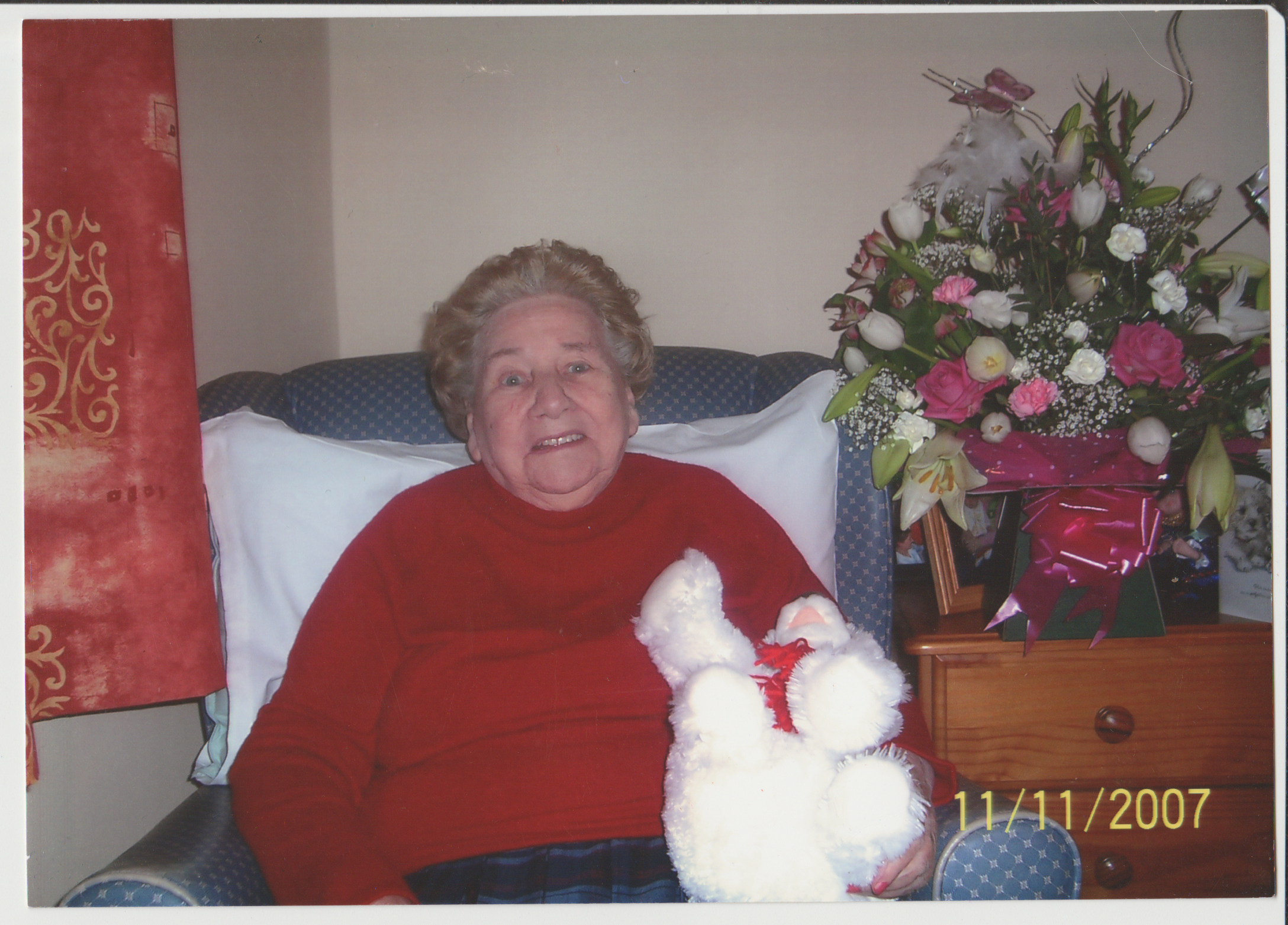Biddie had the most amazing memory and you can listen to her full interview here through Soundcloud!
Biddies’ family go back four or five generations in the area, they were nail-makers.
Biddie: My family used to fish, they fished in Killaloe a lot. My father worked in the Board of Works, down on the scheme.
Did they fish for themselves or commercially?
Biddie: They fished for themselves and commercially, they used to have boats going up and down the Shannon fishing, and they used to take fishermen that would come to the Hotels, like to the Shannon View and the Lakeside; they would take them up the river fishing, so they used, they did an awful lot of that.
Only in the Summer Season?
Biddie: In the summer season. They used to do a good bit of eel fishing at night.
The first eel weir was across, from the last house there on the Canal bank, there was a kind of a bridge across there, they used to fish there first, that’s where the eel fishery was first and then it was shifted up here.
Then my father worked in the Shannon Scheme.
What hours would he have worked on the Shannon Scheme?
Biddie: He used to go early morning, he could leave here maybe about six in the morning, it was mostly cycling that time, there were no cars around that time much.
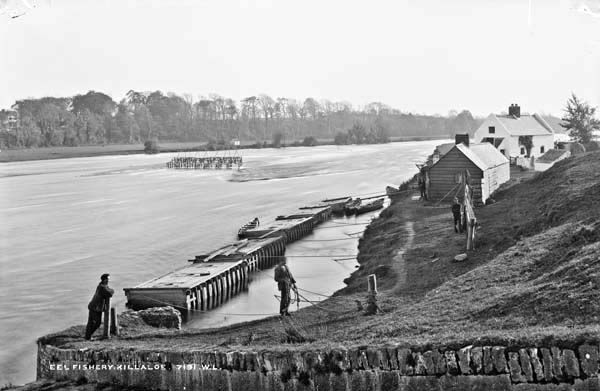
And what would he have earned a week?
Biddie: I don’t know what the wages were that time, that’s going back a good bit.
What would your great-grandfather have done for a living?
Biddie: He’d probably have been making nails, a lot of them were nail-makers. They had a pony and cart and they’d go off to Scariff and off that side of the country with the nails selling them, they used to go the whole countryside.
To the shops and to blacksmiths?
Biddie: To the shops and probably blacksmiths as well.
Did you ever see them making them?
Biddie: No I didn’t, it was long before my time. I don’t remember my grandfather now at all.
Where did they work from? Where was their house?
Biddie: They lived on the Canal Bank, I think it was the second house on the Canal Bank.
Would they have employed anybody or done it themselves?
Biddie: Ah probably have done it themselves.
My father used to hurl a bit and my uncles used to hurl with the Killaloe teams. I have a photo of him there with J.H. Ryan and a cup back in 1912, I think. My father was in the army, he was in the British army, he was in France and out there, he was wounded out there, he had a big lump of shrapnel taken out of him, he had only one lung after that.
Was he married then?
Biddie: It was after the war he was married.
Then I had an Uncle, Peter, he was a great swimmer, they used to have regattas here then and he was the only one that used to walk the slippery pole every year, he was great in Regattas. And he used to teach a lot around Killaloe to swim.
Where did you go to school?
Biddie: I went to school down there in the National School.
Who were the teachers?
Biddie: We had Sister Albert, Sister Celsus, Sister Anunciato. There was a Miss McKenna from Ogonnolloe, she used to teach there, and we had a Sister Malachy in babies class I think it was and there was a Miss Fahy a lay teacher in the convent that time too.
What age were you when you finished school?
Biddie: I finished school around fourteen.
What did you do then?
Biddie: I used to work at Courtney’s, below on the Main Street, they used to deliver milk there and I worked there, I even worked there while I was going to school, we delivered milk night and morning.
Where was Courtney’s?
Biddie: There on the Main Street where the Chipper is now, was Courtney’s shop.
What were they selling?

Biddie: T’was all groceries and they had a farm there, with cows and calves, they sold all farm stuff there, all Ogonnolloe side would come in there and Ballina, t’was a very big grocery shop. We would be there in the evening and we would be weighing up the meal and the flour, that time, all that stuff had to be weighed, you would not be getting it in packages like now, and the eggs would come in and the country butter and that time you could box a lot of the country butter and send it away, take it to Birdhill to the train and send it away to different places, and the eggs the same way. A man would come around once a week and he would give you big huge crates and you would crate all the eggs at night, and in the evenings after school, you would go in there and you would wash all the eggs and put them all into crates.
People would come in with them in buckets and they would have the butter in big enamel buckets, muslin cloth wrapped around it, and you would weigh it up there on the old scales on the counter, and write down how much butter they had and they would get their groceries free then for whatever they made on the butter and eggs.
Did you just do that after school or did you do it full-time?
Biddie: I used to do it only after school.
How much did you get paid for that?
Biddie: I used to deliver the milk in the mornings, one of my sisters used to deliver it, and when she got older then, she started below in the Band Hall for the factory, Mr. Benson’s Factory came, and she was one of the six that started down there, and I used to go in then to Courtney’s and do all that.
That time you would have to deliver a lot of milk, there was no one else delivering milk or coming round with milk then, you’d have maybe seven or eight cans of milk on your arms going around.
Who would you deliver it to?
Biddie: We would go all down the Canal Bank, and we would go down to the old Curate’s house down there to the Priest’s house.
Who was the priest then?
Biddie: That time there was a Fr. Casey here and Canon Molloy, who died saying Mass one morning above in the Church, and Fr. Clancy I think was here, Fr. O’Brien, Fr. Harty.
You said your sister started work in the Band Hall for Mr. Benson – can you tell me a bit more about that?
Biddie: When Mr. Benson came to Killaloe first they had no place to start up so the Band Hall was let to them, because the Band Hall was belonging to the people of the town, they used to run dances in it, the F.C.A., and the L.D.F. and all them used to have great dances below in the Band Hall. They had a band in Killaloe one time, and they used to train down there and it was they started up the Band Hall down there.
What was the band called?
Biddie: I am not sure what the band was called, Annie D’arcys father was in it now and a few like that and some of the Grimes were in it.
Was it the Temperance Band?
Biddie: No I’d say it was further back than that. Mikey Daly on the Canal Bank was in it, a brother of Mrs. Grimes. That’s going back now a good bit. The Kissanes came on after that, their band was after that.
But Mr. Benson set up below in the Band Hall and he brought in machinery. He had four or five machines down there going and Bill Darcy was the first Van man and Billy Kissane, they were the first van men I think he had, and they started down there, until he built the factory out here and they moved from that then out to the factory in Newtown, and then they started taking on more and more, that’s going back now fifty two years.
And when did you start?
Biddie: I did start for a while.
I was going to go to England, because my sister then went out there. Mr Benson had a brother in England who had a factory in Leicester, and he sent over three or four out of here, to show them over there how to work, show them the work they were doing here and she went over there then and they were going to send over more, and I went out for a while to learn outside, but I didn’t go then, I gave it up after that, I never went. Then I didn’t go back then to Benson’s until about seventeen or eighteen years ago.
In between that, I worked in the Convent and the schools below, cleaning the schools and doing convent work inside, cleaning inside, then I used to do half days below at Dr. Courtney’s, she was related to, she was a daughter of Mrs. Courtney’s on the Main Street, the shop where I used to work, she lived there where Jimmy Whelan has the house now, that was all Doctor Courtney’s and I used to do a couple of half days there in the week working, with Moira Ryan. I was there for years with her.
When I left the Convent then I went into the Weavinq factory for a couple of years, I was there for two or three years in the Weaving.
Where was the Weaving Factory then?
Biddie: The weaving factory, they were in Crowe’s, overhead Crowe’s shop, Kathleen Nash’s shop now, and in the back, inside, they used to do alot of work there, and then they built the one down here. I think they were in the Band Hall too for a while. They used to let it out like that, the Band Hall, and then they got the one down here built, Killine. It was the Weaving Factory got that built.
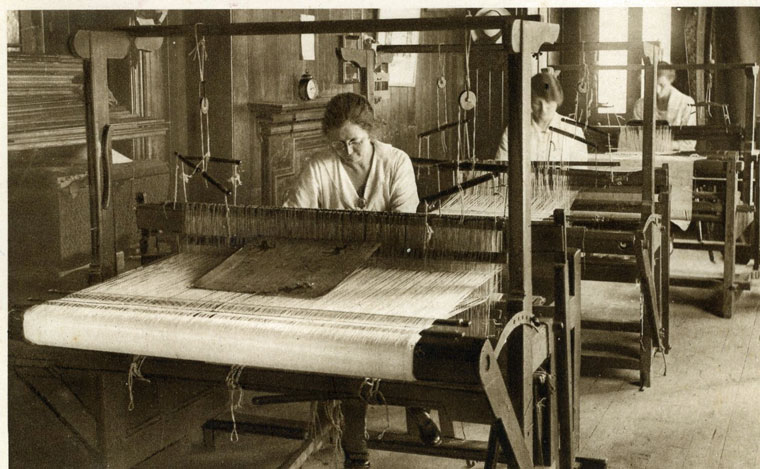
Who would have paid for that?
biddie: I suppose the Government or the Council had so much money to put into it.
They didn’t collect around the community or anything did they?
Biddie: No, they didn’t. Not that I can remember.
They had a good business going there for a while, they got in the big machines and the looms, all the material was made down there, t’was only brought up then to the place over head Crowe’s, to be examined.
We used to examine it like, in one room over head, you would have many hundred yards of material there in front of you, pulling it in towards you and examine it, and if there were threads left out, you would have to sew them in the same as the machines in a big lot of material.
Would that happen very often?
Biddie: Oh it would, because anything could go wrong with the machines below, the looms, you know cause you’d have maybe there of four different threads working you know, and if they were doing a bit long piece of material, you’d expect a lot of mistakes in it.
And then they made scarves and they would come up above and we would finish them off, and then you’d parcel the material and it would go away to Dun Laoghaire for dying, I think it was Dun Laoghaire they used to send it too. Paddy Crowe and Mike Crowe would take it off to the train in the evening and that would go away for to be dyed.
How many worked down there in your time?
Biddie: There could be maybe ten in the factory here and there could be ten maybe above in the finishing room and then maybe four or five in the ironing room.
Was it all women?
Biddie: No, there were boys in it. Babba’s son, Pat, he was doing the weaving, and Nonie Cahill’s daughter Doreen, she was a great weaver, and then there was Johnny Halloran, they started down in the Band Hall, a couple of boys from O’Briensbridge, John Howard was in it as well.
And who was in charge of it?
Biddie: Mrs. Ryan, Mary Minogue, she was in charge of it, I think Jack Crowe had something to do with it as well, and then they had a Manager from Cork, he used to teach them down below, he used to teach them the weaving, Mr. Falvey I think his name was ………… he used to stay at Mrs. Hinchy’s.
How many years were you there?
Biddie: I spent three or four years there at that.
And what would you have earned a week in those days?
Biddie: You would have I suppose up to twenty pounds per week, or maybe more – we used to do a bit of knitting in between, we’d knit the caps and the aran jumpers, that was extra, and you could do it at home, so you could earn a bit extra that way, you could knit alot of those bulky caps, we used to do a lot of knitting, aran stuff that time, they used to send them to Shannon and they’d be on display around in all different places.
Could you name any of the families that lived in St. John’s Street?
Biddie: We lived down in John Street for years. There was Mrs. Tully, Bridget Tully’s mother and father, they were reared down there; there was Mrs. Barry, May Barry, she is dead now God Rest Her, she was a cousin of Moira Ryan’s in Abbey Street; then there was Mrs. Dwyer, Martin Dwyer and his sisters were all reared down there – do you know Mrs. Dwyer in New Street, her husband; then there was Magee’s, Josie Geraghty’s grandmother; then there was an old crippled woman that used to live down there, she was a Mrs. Reddan, I think she could be a very far out relation of Paddy Reddan, when we were young, we used to do the shopping for her, and then there was Molly Hogan, Bridgie Tully’s sister; Mary Hogan and Ann Hogan, their mother, they lived next door to us.
Then there was an uncle of mine, he lived there too, and then there was an Mrs. Linton, Chrissie Linton, she came from Church Street, she was McInerney herself, her brother was a Postman, Eileen McInerney, she lived there on the Canal Bank, she is a few years dead now, they lived there in Bridge Street.
Then there was a tailor that lived in there, I think he was Larkin; we had an Undertaker in John’s Lane, straight over opposite the houses, he was Mike Larkin, his brother was married there, they owned the big corner shop where Crowe’s have the Amusement centre now, there was a drapery there, they were Larkins, Maura Larkin, she married one of the Edmonds, the teachers, her boys often come now, they went to America, well, her mother and aunt lived over there, her father was the Creamery Manager in Ballina, they had a big drapery shop there, all around that block now.
Well Maura’s uncle was the undertaker then out in John Street, he had a big house there, he wasn’t married.
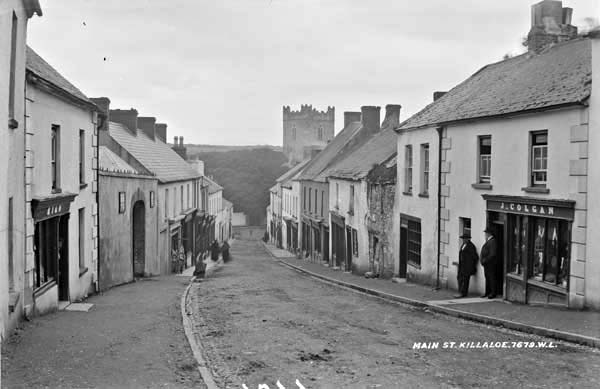
Did he make the coffins himself?
Biddie: Oh he made the coffins as well there, so he did.
Was there ever a church along there?
Biddie: No I don’t ever remember a church.
I remember the Ryan’s big yard there, there was alot of old houses, they had a Bakery in there one time, we used to go in there playing when we were young.
But I never remember a church. There is some kind of a well at the back of the Bank
From your younger days, do you remember any of the people of the businesses on the Main Street?
Biddie: There was Thomson’s; there was Miss Shanahan, where Gleeson’s are; and J.H. Ryan’s shop; there was a little shop where Pat Mulcahy’s was, that was Moylan’s, they had a little shop there – there was a mother and two sons there, she was a mid-wife; Carmody’s lived in there where Howards are until the Byrnes’s came in there; and I remember Franklyn’s lived in Byrne’s big house, they were Protestant but I don’t know where they were from – they used to have a big hall there in that, all the men would go to play billiards; then Duggan’s were there, Peter Duggan – he had a small farm and a couple of cows;
And then above him was Mrs. Nihill, she had a big Drapery Shop, she was an old woman as well, I think she was some way connected to Mrs. Nihill that lived on the Hill Road, her husband was a stone-cutter;
then Matt McGrath’s shop, that woman was another sister of Mrs. Nihills’ in the Hill Road, then we had a Public house here where the Flower Shop is now, Matt McGrath and wife had a Public house there; and go up along then there was Mary Comer’s house, Gastronomes was above that, there were two houses there;
Mrs. Nihill had a shop there and then there was Comer’s above that, you see them two places are all into one now, but they were two separate houses then;
and then there was Pa Grimes house, which is Mary Egan’s house; and then above that where Mrs. Crowe lived, that was a Public House as well, that was Martin’s; and then there was a little shop above that she was a Miss Keogh, a great friend of De Valera, she had to be brought up to the Green every time he came, she would sit above on the stand with him; there was a bicycle shop above Miss Keogh’s, that was Welsh’s Bicycle shop, they lived where Tom Cooney lives; above him then was Jim Donoghue, and above that then where Michael Moloney is was another Public house, I think they were Miss Reynolds or something; and then up along further was a Butcher shop – McMahon’s; and then there was Hanna Ryan’s house, they used to sell milk there too I think; I think it was Bourke’s lived above them in Peg Kiely’s house, Bourke’s were farmers as well; across then where Sullivan’s are, that was Minogues – Mary Minogue’s mother and father.
Did they have a Bakery?
Biddie: Yes, Mrs. Minogue’s people, McCarthy’s had a Bakery there. I don’t remember that but I used to hear my father talking about it – they used to go in there for the buns for the lunch when they were going to school.
Then you come down along the other side, there was a lot of different ones – Mrs. D’arcys people lived where Joe McMahon lives, I think it was her father and mother lived there; and then Bourke’s shifted over to the other house, where Mary McGrath is, and then it was sold to Miss Brien, she came in from a farm on the New Line; and then there was a Booking Office where Heaney’s was for a while; alot of different ones came in there and had different things in that, it was a Booking Office for a while and then a Solicitor had it for a while; then Collins’s owned where Reddan’s were, they had a Public house there too, they had a son Michael, who used to be in all the plays in Killaloe; and then there was Richardson’s, I always remember Richardson’s being there back along, Freda Phelan’s grandfather; and then there was the Miss Herbert’s, they had a shop below that, they had a Drapery Shop there, two ladies – they came from up Boher side, where the Credit Union is now, next to Richardson’s, you could get all your wool there, overalls and things like that; and then there was Buckley’s, where Mrs. Kelly is; and then you had Crowe’s Shop, and then you had the Dispensary and the old Post Office.
Woods house was all Crowe’s house, all that block belonged to Crowes; from there down to where the Chip shop is belonged to Tom Courtney’s – his mother and father. Then next to it you had the old Post Office.
Then there was the Barber’s shop and then there was Moore’s, that man was a baker, he used to bake at Crotty’s; there was three houses there – there was the Post Office, then Collins’s, the Moore’s.

The next place down along was all Tom Courtney’s, he had a Dairy there – I think that’s where the Shoe-maker is now – and then there was the Bow, a big Bow – then there was the dwelling place and then the shop – they have it all changed now up along since they had the Butchers shop – where Courtney’s used to have their sitting-room, that was all a butcher’s shop there. That time you had to have a dairy to do the milk and the eggs, they used to sell them in the shop but it became compulsory that you had to have a special dairy so they built a dairy up that end of it. Then you had Mr. Behan’s, a Chemist shop below that; then Timmy Maloney’s father and mother lived in a little house below Behan’s, I think that is now let into Mrs. Bowers’ place; and then you had Miss Ryan and Annie Cullen, they had a Public house there where John Grimes is; and then that was the next Post Office after that, that was George Waterstone and his wife, she was Peg Flynn of Killaloe; then below that you had all Crotty’s then, yards; and below Crotty’s bow-way, you had Malonev’s, John Maloney, he was a butcher in Killaloe, they lived there, they had a big butcher’s stall there on Main Street; and the rest down then was Crotty’s, down to the corner.

Then in Bridge Street, you had Matt the Tailor, he had a room there with his mother, he used to do tailoring there and Gerald Brooke’s wife was a tailoress there with him – she learned to be a tailoress there with him; and below that then was Gleeson’s shop, that was a sweet shop and bicycles as well and a paper shop; Haskett’s lived below that, Tom Haskett’s mother and father; then there was the Shannon View Hotel.
Across from that then was P.J. Vaughan’s house, a shop and Public house; where Mrs. Mickey Reddan lived was Neary’s, a Public house as well; and then above that, where Mrs. Cleary lived used to belong to an aunt of hers, she was Mrs. O’Connell, I think, she had a lovely little sweet shop there; and then you had McGrath’s Public house and where Andy McGrath lives was a sweet shop as well, it was a Mrs. Whelan; and then the corner all around was Larkin’s Drapery.
Then Church Street, I remember Willie Minogue’s, the butchers; and there was the Rafferty’s, they all lived there, Margaret Rafferty and her brothers; and then below Minogue’s several people lived in the house, where Leonard’s live, there was a bicycle shop there one time, and they used to sell radios and things; below that was Lucas’s, Tom Grimes’s wife, her mother was a dress-maker, she lived there; and then we had a little house below that, Pat Keane lived in it, he worked at Crowe’s in the shoe-department; and then there was the Dance hall and the Bank.
Across from that then you had Mrs. Ryan, her and her sisters there in that shop, and there was a Public house there, the Flynn’s, they had a farm out the road – there is a Public house there now as well; and then there was Mrs. Hinchy, but she did not always live there either, but she is there a good number of years; and then there was McInerneys, one of them was a Postman, Mrs. Floyd is living there now.
Then down New Street, you had Michéal Hogan’s father and mother, they had a Public house there; and there was a whole lot of small houses.
There was a Jack Kissane there, he had a shoe-maker’s shop in it, he would have been an uncle of the present day Kissane’s. Then Mrs, Lynch, she used to teach in the choir, her house was down at the corner, where Pat Reddan is living now; and then there was Mr. Lynch, that used to work in the Bank, he was there in later years; and then Doctor Holmes, Maura Madden is living there now; then across from the school, where Josephine Horan is living now was Mr. Lynch, the School master; and come up along then, where Mrs. Moore lived then, there was all guards; then there was Lynch’s, Rafferty’s, they lived along up there, where Mrs. Mattie Brien lives now, that was a shop as well, it was Barton’s, they would be related to Mrs. Toher, she lived above that big house above that; and then there was Guard O’Connor; down below him two or three brothers lived, they were Conlon’s Frank Conlon and his brother; and then Lefroy’s lived in the big house where the Priest is living now, Canon Clune’s house; across from that then were the Keogh’s, Frank Keogh and his brothers they lived where O’Shea’s are now; then the rest down along were only fields, the Bane field and the rest of the fields down along.
There was a row of small little houses in Newtown. There was only the ex-soldiers cottages in Newtown that time.
I had an uncle that lived out there, Uncle Francie used to live out there;
Mulqueen’s lived there; Molloy’s lived out there; Tucker Hogan’s father lived in one of them; Mick Quigley lived in one; Kitty lived in one, Sarah Malone, she was Sarah Connell, she lived next door to Kitty Quigley.
Then up at the back on the hill there was Molloy’s, O’Donnell’s, Josie Maloo, alot of different people lived in those houses.
I remember Parkers in Ballyvalley, and Stoney’s. Parkers used to deliver milk on a little pony. Tess Hogan’s father used to deliver it around town on a little ass and cart around the town for them. Paddy Costello that lived here on this road worked in Stoney’s.
There was a lot of small houses down Carrick’s Lane that time, people lived down along there. Then there was a bow there above Mary Egan’s house, you could go in there between Crowe’s and Mary Egan’s house, and down along that side there was another row of small little houses, people lived in along there – Courtney’s and Keane’s and McInerney’s and all them lived there.
If you are in John Daly’s shop, where the Forge was, and you turn up the lane there to Chris Minogue, there were two houses there, facing Chris Minogue’s slaughter house, there were two little houses there, Shaughnessy was one, he used to work across at Minogue’s in the yard, I don’t know who lived in the other one.
Then there was only the Miss Keogh’s on the Convent Hill – the dress makers, there the school then and then there was Flaherty’s, he had something to do with the Mill, Dan Flaherty, he used to be in a wheel-chair and his sister Lena.
Then at the lower end of John’s Lane Moira Ryan lived; there was a Paddy Barry, he would be an uncle of May Barry, he lived next door; and then Mrs. O’Brien on the Cross Road, lived in the other house; there was three houses down at that end of it and there was a pump facing over to Jimmy Whelan’s house;
Then on Abbey Street there was another Barry and there was Julia Hurley, I think Eileen was a niece of Julia’s, she used often play the organ in the Chapel and she often played the piano in concerts and things, they owned the two houses there where Mrs. Prendergast is living, that was all one big house; there was a Paddy Barry there aswell living where Moira and Josie Ryan are living now; the Caretaker in the Protestant Church lived there as well.
Where Mrs. Jones is living now was Martin Curry and his wife – that is why it is called Curry’s corner, he was our old Postman.
Then you go out the New Line, to the Band Hall, and over from the Band Hall there was a big wall, and there was a hut inside that, and it was called the Iron School, where the Protestant children went to school, they would come in from the Birdhill side and around that area, into school for a while, and then they would go off to higher schools; then you go down to Clarisford and Deane’s lived in the lodge and then there was the Palace above, Bishop Patton and Perdue and all those protestant Bishops lived there;
and then you go out the New Line, of course it was all fields out there, you had the great circus field, circuses always came there, you had Duffy’s and Lenten’s, they all came there, you would get in that time for a couple of shillings, six pence maybe, that time they would stay a couple of days in the area, they would always come in the summer time;
and then there was another big field over opposite that with a big pond in it, Flynn’s field we used to call it, we used to go skating, when the ice would come, that was opposite Ward’s Garage, where the house is.
I remember Ryan’s Garage there, Jim Ryan built a little house there on it and he had a garage, that was the first of the garages.
Further out where Daly is living was Cordue’s, there was a couple of sisters and brothers; and then there was Molly Mac’s at Killestry bridge; and then down at the other side of the bridge, was where Michael Moloney lived, and out further then I think there was no other house until you came to Mickey Mulcahy’s big house; and out a bit further was Brian Dairyman’s and Crowe’s, a couple of brothers lived there, some of them worked on the boats, I think. They were no relations to the Crowe’s in the town, one of them married Poll Graham, they lived down in the Mill, the Graham’s, between the two waters.
You go out along there to O’Briens Bridge and there was not many more houses out along there.
I don’t ever remember anybody that lived in what some people called “old Killaloe”, down at the bottom of Clarisford, we used to go down around the back of that in summer, playing and collecting sticks. There was a couple of long houses on the other side of the palace, where the Care-taker lived. They were strict down there, but you could go down around collecting timber and sticks, they never put you out, down at the back before you go up the hill to the Palace, there was a road in around that way, down around to the woods. There is a big cross down there at the back, a big Celtic cross kind of thing.
John Mulcahy’s father and mother lived down there and there was a Cusack man, the man that takes the photos, his father and mother lived there. My eldest brother used to do gardeninq for the old Bishop; Bishop Patton and Cusack were there in his time – Billy Cusack was an only son – that is him that takes the photos now. I remember him living down there.
Then out the New Line, beyond Killestry was Tierney’s, their father was the Gardener down there at the time, Chrissie Tierney and her sister.
In the town then around from Curry’s corner, was Bill Brown, he had a timber place in there, a saw mill in at the back, he lived there where Mrs. Mahony lived; the first one, you could go down there for timber or blocks, then around from that P.F. Ryan had the garage there, he sold petrol and bicycles there, that place is still there, it is up for sale now; there was another little shop then where Mick Gough lived, that little house below the Bank, Mick Honan and his wife lived there, a little sweet shop.
I remember Mrs. Prendergast’s husband was working in the Bank that time.
I remember the Scanlon’s in Abbey House when I was young, and then you come round to the Cinema, that was a great place, they used to teach boxing up in the top of it; then there was a Ryan living where Tom Grimes is living now, he worked in Keogh’s office; and then Doctor Henry Keogh lived in the next house where Danny Collins is living now, he had three daughters and two sons, I think he practiced in Limerick or somewhere.
Then there was Miss Annie Keogh, the big house, between Danny Collins and the Anchor, that was a kind of a hotel as well; and Vaughan’s Pub – that was where the Anchor is now.
Then you cross over to the Shannon View, that was a big building; and then you had Miss Grace’s hotel, where Sean Ryan is now living, she used to keep all the English fishermen; and then there were a couple of little houses on the Aillebhaun, Peter Lacy in the first one, Brendan Deane’s father and mother in the second one.
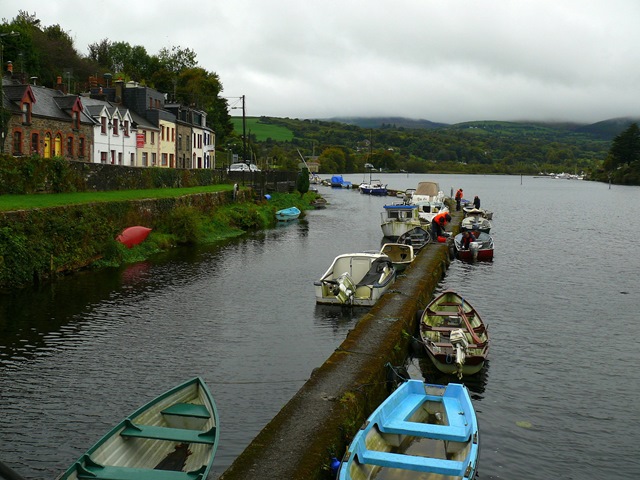
Then you had the Canal Bank, with the Malone’s, the Noonans, Miss Long, some of the Kissane’s lived there for a while, a Guard O’Neill lived down there, the Reddan brothers had boats there on the Canal, there was Joe Reddan, there were three brothers, and I think Keeshan’s lived there, Millie Touhy lived in the first big one then and then Mikey Daly’s mother lived in the other one. Millie Touhy’s father used to teach French, and in the last house then was Timmy Maloney’s mother and father, they moved down from the Main Street down there.
In the Pier Head then, there was Johnson’s; and then there was the well at the back, a fresh well, it’s still there, there was supposed to be blood on stones where someone was shot there, they say it is true, a lovers tiff or something.
Those Johnsons would have been related to the Lucas’ in Derrycastle. They used to run that place, the dry-dock, people used to work down there, boats were repaired there.
St. Flannan’s Road was just a big field, and McInerney the Contractors built those houses for the Council on it. I don’t know who owned the land, but I know Paddy Reddan owned the top part of it, they have their own garage.
Across from it now, ex-soldier’s cottages were there, there was a Mrs. Collins, Fred Collins’s mother; and then there was the McEvoy’s in the first one, they had a little shop at the corner; then there was Matt Mulcahy, the Tailor, he did his tailoring below in Bridge Street; and then there was the Lyons family; and then there was Tommy Malone; and around that at the other side, where the girl of the Costelloe’s is living now, was Georgie Fitz’s, he did alot of fishing.
Then the Cross Roads was all fields as well, Cordue’s fields we used to call them – and then down along there was a row of little houses. One fine big house in the middle was Twomey’s, he had a little Forge at the side of it as well, it was a big house; and then Jimmy Barrington lived in one of the small ones, all them small houses were knocked.
Chapel Street was a row of small little houses as well, very small little houses down along there, some woman built a bungalow there in the middle, some people came and lived in it – Guard Hyland lived in it; then the lower end where Mrs. Quigley has the shop was Tom Grimes’ home, they lived there; and then there was Nurse Morgan, the Mid-wife, that is all Quigleys now.
Where Doctor Carmody is now, was a big shop and Bar – that was Dan Courtney’s, related to J.H. Ryan and the other Courtney’s on the Main Street.
Then over from it where Scanlon’s are living, that was a bar as well, Maggie Hanrahan, she was a cousin of Tom Courtney, it was Courtney’s shop, she ran it; and then there was small little houses down along, Cassidy, Donnellan, alot of different people coming and going, Winkles lived there for a while in one of them. Then up the Hill Road, there was not much, there was Nihill’s, where Tony Harney is living now. Nihill was a stone cutter, he used to make head-stones. I used to deliver the milk up as far as there, from Courtney’s when I was delivering it. He had a chap working with him, I can remember a Kelly boy working with him for a good number of years. That Kelly man, he married a sister of Flossie Moloney’s, and they lived down in Birr. At the time, I don’t think, there was anybody else around making head-stones.
The head-stones were made from stone, it would come in a big slab, and he would cut it down. There was another man that lived up in Killestry, himself and his son used to make them over in Keogh’s yard one time as well, Courtney was his name. Back out at Newtown, where Stritch’s are living, Courtney’s had that shop, a couple of brothers lived there and a sister, there was no garage there then. There was a big house there where a Scanlon man lived; on then was Kitty Connell’s house, there were three or four brothers and a sister there; and then you had Captain Stoney’s; and then out along to the Fort was only all fields.
You had Parkers up in the big house, Ballyvalley House; and then you had ex-soldiers cottages as you came in along, you had Robinsons, Mulqueen’s, Noonan’s, Hogan’s, Connell’s, Molloy’s, Hinchy’s. Where the cottages are now in Newtown, you had Mickey Hogan and another Hogan man, and there was Lewis and Murphy’s, he was a Postman here, that’s all I can remember.
Where Curtin’s house is now, that was a sandpit, Ryan’s sandpit, belonging to J.H. Ryan.
The Edmond brothers Secondary School started above in Rose Cottage, that little house near the Hurling field, they were there for a good many years, and then they moved. I think their next place was in Church Street, down where Jim Leonard lives, they were there for a good while too, they moved from that down to Frank Keoghs in New Street. There were four brothers of the Edmonds teaching there. They had a good lot of pupils, they came from Ogonnolloe and all around the district.
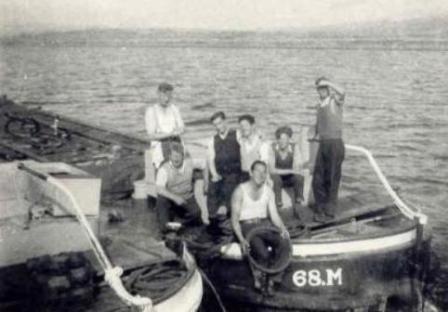
I remember the barges coming down the river and they would dock below there at the Mill, the Canal Store, we used to call it. Mr. Gibbons that lived in New Street was over the Canal Store, they would take in all the stuff off the boats in to the Canal Store, and they would go on into Limerick with stuff. Shops around the town would go down with their little pony and car and bring the stuff up to the shops. You would hear them coming in, above at Parker’s Point, you would hear the noise. You got used to them then, they were parked in the Canal and the Shannon. Anthony Donoghue was on them, Mick Conroy, Bertie Conroy, Mickey Connolly, he had three or four brothers on them, Kitty Cummins father was on them, there was alot around. Larry Moloney, him and his father and all his brothers were on them, they came from Banagher and Dublin. Tommy Lawlor was on them aswell.


